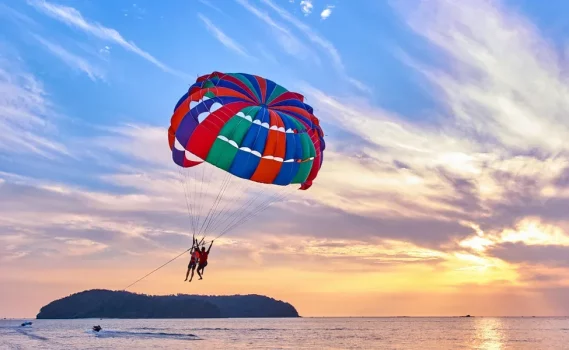Many nations have made parasailing a top tourism destination. Many individuals want to try it out but are unsure of what to dress since they are unsure if they would feel comfortable.
What is Parasailing?
In the activity of parasailing, you are dragged over the sea while wearing a harness that is connected to a sizable parachute and tethered to a boat with a long rope.
There are usually two different kinds of takeoffs. The first involves being gently raised into the air while being hooked to a rope from the back of the boat, and then being slowly lowered back down. The alternative is to run or walk down the beach before being launched into the air. With the second choice, you often land in the ocean.

When Should I Go Parasailing?
Going in the summer or to a place where the temperature is in the 80s or higher is something we’d advise. Warmer temperatures are necessary for any activity involving water. In order to have a good time and to feel safe, the sky must be clear.
What To Wear Parasailing?
The weather should be taken into account more than anything else while deciding what to wear parasailing. Dress for the season and kind of weather you might expect on the day of your parasailing experience. Bring a jacket or sweater with you if it’s chilly outside, and light attire, such as shorts and t-shirts, if it’s hot outside.
Personal choice should be the second factor you take into account while deciding what to wear parasailing. Shorts or skirts are preferred by certain people while long pants are preferred by others.
The third factor to think about is comfort level. Some people may like greater leg covers, while others may prefer more arm and leg mobility.
A comfortable bathing suit or quick-drying underwear is advised for the base layer of clothing. You’ll probably be spending the day at the beach as most parasailing activities take place there, so dressing in your swimming suit is a great idea.
Bathing suit bottoms are the ideal top layer for men. Then wear a sports shirt or rash guard that dries quickly with it. We advise women to wear swim shorts (as a layer of defense against the harness) and then a quick-dry shirt or rash guard to shield them from the sun and the life jacket.
Kids: Make sure they are covered so that the harness, life jacket, and sun don’t damage their skin. For both boys and girls, a swimming suit with a cover-up is advised.
Tech Gear: Documenting a parasailing adventure is a typical desire. You might be curious about whether you can bring certain gadgets like smartphones, GoPros, or even drones on a parasailing vacation.
Drones are not permitted since it is against the rules for parasailers to sail when something else is in the air. The quickest way to wrap up your parasailing trip is by pulling out your droid and flying it around you.
However, phones and GoPros are okay. Using a Go-Pro is a common approach to capture sports and action-packed events. It may be fastened to a stick, your breast, or even a hat. You should wear a strap with your Go Pro if you intend to bring it along on your parasailing trip.
The majority of telescopes and sticks feature some kind of fastener that lets you secure them to something. In this situation, you should fasten the stick to your life jacket. You won’t lose the Go-Pro if you drop it or if the wind rips it out of your hands since the stick is fastened to the Go-Pro and the stick is fastened to your jacket. You can travel with your phone along with everything else.
It’s a good idea to have a waterproof phone case in order to prevent tragedy. The waterproof cover will protect the phone even if it falls from your pocket or gets splashed with water when you’re not using it to record. You can also search for a cover with a strap attachment if you want to prevent falling.
Whether you intend to record with it or not, securing your phone to your life jacket is another excellent idea. Your phone or a GoPro are excellent choices for recording your journey.
How Much SPF For Skin Protection
Make no mistake, even though you’ll only be in the air for 10 to 15 minutes. Regardless of your skin tone, parasailing exposes you to powerful UV radiation; thus, always use sunscreen.
Use an SPF 50 sunblock or sunscreen if it’s summer and the sky is nearly cloudless.
An SPF 30 should be adequate if the sky is overcast. Don’t accept anything less, and submit new applications as often as advised in the package.
What Should I Avoid Wearing?
You shouldn’t wear bulky cotton clothing, such as jeans, when participating in any water activity since they will make you feel uneasy after getting wet. Additionally, avoid wearing clothing that is too loose since it will obstruct the harness’s buckles and clips.
Additionally, we advise against wearing constricting or unpleasant apparel. You’ll sit in the same posture as when you swing when parasailing. We advise wearing shorts that aid to prevent this area from rubbing on the harness because the harness will sit just below your butt on your thighs.
Wearing unsecure goods is not recommended. That means you cannot wear flip flops, a phone in your pocket, glasses without a strap, loose-fitting caps, or valuable accessories like jewelry or hearing aids.
If you wish to bring your phone, make sure it is in a waterproof pouch with a strap that you can attach to your lifejacket.
Conclusion
Families, couples, and single people may all participate in parasailing because it is such a safe sport. By dressing appropriately, you may make the most of your adventure’s fun. Otherwise, relax and take it easy. Nothing compares to the satisfaction of soaring over the ocean.



